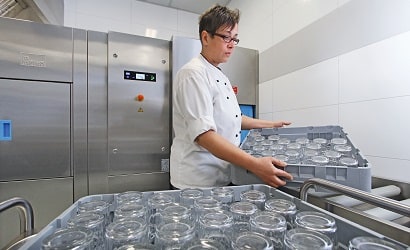
The CDC estimates that every year, 48 million people will get sick from foodborne illnesses or germs. While contamination can occur at any point in the food production chain, foodservice operators are a focal point for proper handling and preparation of food.
Utensils, equipment and serving wares are critically important in food preparation. Not only can their cleanliness impact an establishment’s reputation, it can also be a contamination concern.
Federal regulations and state/local codes provide specific guidelines for food safety practices. Two in particular are tied to warewashing: preventing cross-contamination, and cleaning and sanitizing surfaces that come into contact with food. Proper warewashing can help prevent food safety issues.
Know the FDA Food Code
The U.S. Food and Drug Administration (FDA) publishes the FDA Food Code, an outline of federal food safety recommendations for foodservice operations. Local regulators (city, county, state, etc.) often use it to develop their own food safety codes.
The code details a number of regulations related to warewashing. According to the Association of Nutrition & Foodservice Professionals, there are requirements for warewashing machines:
- Must have a data plate listing operational specifications on the machine, including: washing, rinsing and sanitizing temperatures; required pressures (for heat-sanitizing machines); and conveyor speed or cycle time.
- A measuring device that displays wash, rinse and final-rinse temperatures must be mounted on the machine.
- Machines must automatically dispense detergents and sanitizers, and have a visual or auditory alarm indicating when the detergents and sanitizers have been delivered.
- Self-draining side tables/drain-boards are required for warewashing machines.
Follow “best practices” to minimize food safety concerns
In addition to the guidelines outlined in the FDA Food Code, there are other considerations that relate to warewashing and the handling of food-serving items:
Warewashing techniques
- Load dishracks so that water spray covers every surface; don’t overload racks.
- Ensure water temperature, pressure and chemical levels meet manufacturer recommendations.
- Cutlery holders should be loaded with handles down. Place assorted ware (not identical) into each holder to prevent nesting and inefficient cleaning.
Handwashing
- Handwashing stations are required in restrooms or adjacent areas, food-prep areas, and service and dishwashing areas.
- Handwashing sinks must be used only for handwashing.
Transporting
- Carry clean glassware in a rack or on a tray so that it doesn’t touch surfaces that may come in contact with food.
- Pick up and hold dishes on non-eating surfaces (the bottom or edges); hold glassware by the middle, bottom or stem.
- Regularly clean and sanitize trays and carts that are used to transport clean tableware and utensils.
Storing
- Store clean, sanitized tableware and equipment at least six inches (15 cm) off the floor.
- Regularly clean and sanitize drawers and shelves where items are stored.
- Store glassware and cups upside down on a clean, sanitized shelf or rack.
- Store flatware and utensils with the handles up.
- Cover the food-contact surfaces of stationary equipment until it’s ready for use.
- Store serving utensils on a clean, sanitized surface, or in the food itself with the handle extending above the rim of the container.
- Have separately designated storage areas for clean dishes, dirty dishes, and utensils, in order to avoid cross-contamination.
Understanding warewashing sanitization
Dishwashing machines sanitize in one of two ways: by using hot water or a chemical sanitizing solution.
For machines that use hot water, temperature is the determining factor in good food-safety practices. Sanitization occurs when the rinse water heats the surface temperature of the ware to at least 160°F (71°C), holding it at or above that temperature for several seconds.
High-temperature dishwashers from MEIKO heat rinse water to 180°F (82.2°C) for complete sanitization. This eliminates the need for a separate chemical sanitizer and provides fast drying time with minimal spots. Chlorine residues from low-temp machines that can affect the taste of food and drinks can also be eliminated.
Once dishes and utensils are sanitized, proper drying techniques will help reduce remaining water and prevent the spread of infection. For example, employees should never use towels to hand dry wares, as this could cause contamination.
Good dishwashing machines make drying wares fast and easy. MEIKO’s innovative blower-dryer system, an optional feature on the KA Series commercial rack conveyor dishwashers, uses a single blower with electric heaters to reduce drying time and virtually eliminate spotting. This means little-to-no hand polishing is needed, which reduces ware handling that can transfer germs.
Choose the right warewashing machine
The right dishwashing machine can help you meet food safety regulations, conserve resources to reduce costs, improve operational efficiency to save money, and even make cleaning easy!
MEIKO’s M-iQ flight-type conveyor dishwasher uses a high-pressure wash for enhanced soil removal, which also reduces water and energy consumption. How? This innovative, eco-friendly design uses the water already in the tank to clean itself. The M-iQ filter continuously removes soil from the water and automatically pumps it out of the machine – so it “washes the water.” We know that cleaner water needs fewer chemicals and produces better cleaning results.
Blue components inside MEIKO machines serve as “Blue Clues” for parts that should be cleaned by the machine operator. And even that task is made simpler by an automatic wash-down of the machine interior ‒ making it more convenient, quicker and reliable than other dish machines.
Keep your kitchen safe
Dish rooms and warewashing equipment are an integral part of food safety programs. By implementing warewashing best practices, following FDA Food Code requirements, and using the right dishwashing machine ‒ you can help ensure a more positive guest experience, easier and more efficient operations that save money, and a citation-free health inspection.
Further details:
To learn more about MEIKO’s cleaning, sanitizing and disinfecting solutions for foodservice operations ranging from restaurants, hospitals and hotels, to schools, catering and rental companies, visit: www.meiko.us/.
